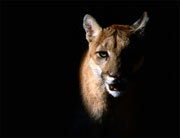Trees giving bizarre clues to climate change
By Sandi Doughton
Seattle Times science reporter
CARSON, Skamania County --
Suspended 20 stories in the air, Ken Bible looks down on the crown of a 500-year-old Douglas fir and ponders amystery.It's not the obvious one: How does a man without super powers hover abovethe tree tops? That's easy.
The University of Washington forest ecologist rose to his lofty perch in a metal gondola hoisted by a 285-foot-tall construction crane. The vantage point allows Bible to study the upper reaches of this old-growth forest, where a reproductive orgy is under way."We've never seen anything like this here," he says, reaching over the edge of the open-air gondola to grasp a limb laden with cones.
He counts at least 30."Normally, a branch like this would have about three," he says. "Why so many this year? We really don't know."Maybe global warming nudged the trees to procreate. Perhaps it's a natural cycle. In either case, Bible wants to pinpoint the trigger. Did the forest crank up cone production in response to temperature? Is moisture the key? Or could the flush of fertility be traced to high spring winds that whipped up a sexy cyclone of pollen? The work is part of a bigger effort to figure out what climate change, both natural and man-made, will mean for the Northwest's iconic forests.
The UW's Wind River Canopy Crane, erected in 1995 near the Columbia River, is proving an ideal tool. The crane and the research area that surrounds it have already helped answer several fundamental questions about forests and their ability to counteract global warming. A cooperative venture with the Forest Service, the crane is the largest in the world dedicated to forestry research, and the only one in North America.
It was here that scientists put to rest the myth that mature forests are biologically moribund. By rising above the treetops, they were able to take measurements that showed old forests continue to grow and act as a sink for carbon dioxide, a major greenhouse gas.
Studies here also proved it doesn't make sense from a global-warming perspective to cut older forests and replace them with seedlings, which grow faster and had been thought to absorb more carbon dioxide.
Old forests are storehouses for such vast amounts of carbon that it would take many decades for new forests to catch up on the carbon balance sheet.
Go to the website to see the drawings of the crane with trees --Fabulous--Amazing!
Less Happy News of the what goes around comes around variety Here:
Kims' Clear-Cutting of Korean Forests Risks Triggering Famine
By Bradley K. Martin and Hideko Takayama
Nov. 21 (Bloomberg) -- In some parts of the world, floods and famine are acts of God. In North Korea, they're acts of government.
For decades, the late North Korean dictator Kim Il Sung mobilized vast work teams to fell trees and turn the mountainsides into farmland, allowing rainwater to wreck roads, power lines and agricultural fields.
Following Kim's death in 1994 -- just before a flood- linked famine gripped the nation -- his son and successor Kim Jong Il continued the sacrifice of forest cover until 2000, when he began encouraging reforestation.
But the shift hasn't reversed the damage, and some analysts warn that another famine, close to the scale of the 1990s disaster that may have killed millions of people, might occur as soon as next year.
``Next year's food situation is quite serious,'' said Kwon Tae Jin, a researcher at the Korea Rural Economic Institute in Seoul. The famine risk is greatest starting next spring, after the current harvest is used up, he said; North Korea's best hope may be for more food aid from abroad as a result of its agreement to begin dismantling its nuclear-weapons program.
Floods in August and September left 600 people dead or missing by official count, and 270,000 homeless. ``Corpses were dug out of the silt'' still clutching vinyl-wrapped photos of the Kims, the official Korean Central News Agency reported.
The hills and mountains still had trees, and I never heard of floods.
Hiroko Saito, a Japanese woman, remembering how North Korea looked when she moved there in 1961. Read the full story
......While the report said reversing the environmental damage through reforestation has become ``an all-out campaign,'' hungry people have continued cultivating crops between the tree seedlings, according to Han Young Jin, a defector from the North who lives in South Korea.
As the branches spread, ``people would tie the sprigs together so the trees could not grow,'' Han wrote on a defector-staffed Web site, Daily NK.
``When the trees inevitably died, new saplings would be planted.''















































0 Comments:
Post a Comment